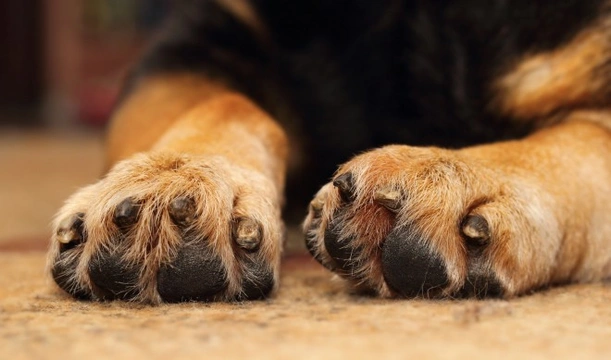
Swollen Dog Paw: Causes, Treatment & Home Remedies
Swollen paws in the dog, or more commonly, one swollen paw, is a relatively common injury, as most dogs do a lot of moving around on different types of surfaces in the course of their average day! In some cases, the cause will be clear, such as a thorn embedded in the foot, but in other cases, it is not so easy to work out!
Swollen paws in the dog may be due to a minor problem or something more sinister, and so it is worth learning more about how to check the paws, narrow down potential problems and find out what to do next. We will cover these factors in more detail within this article.
Common causes of swollen paws in the dog
Some of the most common reasons for why one or more of your dog’s paws may be swollen are:
- Allergies.
- Sore paws from too much exertion on hard surfaces.
- Burns to the paws from walking on a hot road.
- Damage such as a broken toe.
- Stings from wasps or bees.
- Infections.
- Tumours between the toes.
- Heart problems.
- Injuries such as a foreign body being lodged in the paw.
How many paws are swollen?
First things first, getting to the root of the problem can be simplified a lot by doing some deductions based on how many paws are affected.
One swollen paw is likely to mean a foreign body in the paw, injury to one paw, or possibly, that their paw has been stung by a wasp or a bee. Check the claws too, as a damaged nail can also lead to swelling, and it is also important to search between the toes for any signs of a tumour or other problem.
If both of the front paws are swollen but the rear paws appear ok, your dog may be suffering from an allergy that is causing them to lick, chew and otherwise bother the paws. If your dog has sore spots or other itchy areas on their body, this is the most likely culprit.
If all four paws are affected, check out the pads of the paws to see if they may have become burnt from walking on a hot road, or abraded and sore from too much exercise on hard surfaces. Take special note if your dog is also coughing, which may seem to be unrelated, but in combination with swollen paws may be an indication of a heart problem.
Is the leg or the paw the problem?
Narrow down the culprit further by establishing if it is the paw (or paws) itself that is swollen, or if the swelling also involves the leg.
- If the leg itself is swollen along much of its length, the foot swelling is likely to be associated with this, but the injury or problem itself is likely to be higher up.
- If one toe in particular is swollen, or the paw only rather than the leg, the chances are that there is a problem with that toe or paw only, such as a foreign body, broken toe, or sting or bite.
- If the pads of all of the paws are swollen, the most common reason is burning from walking on a hot surface, or damage from walking on hard surfaces. However, crusty, swollen feet that do not appear to be overly painful can be a sign of something more serious, such as lupus.
How to deal with swollen paws
Working out what has caused the swelling is the key to resolving the issue, and will tell you whether or not it is something minor that you can manage at home, or if your dog will need to visit the vet.
- Foreign bodies that are lodged in the paw but that have not broken the skin, or that have not caused a deep injury, may be removable at home. Then, washing and cleaning the paw and keeping an eye out for infection will usually be sufficient.
- If your dog’s paws are swollen due to overexertion, allowing your dog to relax and recover fully, and avoiding high impact or long walks on hard ground in future should help. You may also want to consider soaking your dog’s feet in an Epsom salt solution too.
- If your dog is suffering from allergies, you will need to speak to your vet to get help to narrow down the culprit, and work out how to proceed.
- If your dog’s paws smell cheesy or yeasty, they may have developed a fungal infection, and again, your vet can prescribe a treatment.
- If your dog’s paws are sore due to burns from walking on a hot surface, you may be able to cool them down and wait for your dog to recover at home by soaking their feet. However, if the paws are abraded, bright red or weeping, you will need to go to the vet.
- Don’t ignore sore paws if you cannot find out the cause; there may be something serious amiss, and you should always contact your vet for advice if you are at all uncertain.



